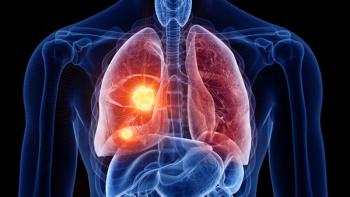
Patritumab Deruxtecan Makes Headway in Early Phase Trials for Patients With Metastatic EGFR+ NSCLC and HER3+ Breast Cancer
Patritumab deruxtecan generated activity in patients with metastatic or unresectable EGFR-mutated non–small cell lung cancer and HER3-expressing breast cancer.
Patritumab deruxtecan (HER3-DXd), an antibody-drug conjugate (ADC), demonstrated clinical activity in a phase 1 trial (NCT03260491) assessing patients with previously treated EGFR-mutated metastatic or unresectable non–small cell lung cancer (NSCLC), and in a phase 1/2 which enrolled patients with HER3-expressing metastatic breast cancer (NCT02980341).
Results from the phase 1 trial showed that patients with EGFR-mutated NSCLC (n = 102) treated with patritumab deruxtecan experienced an objective response rate (ORR) of 40.2% (95% CI, 30.6%-50.4%), including a complete response (CR) rate of 1.0%, a partial response (PR) rate of 39.2%, a stable disease (SD) rate of 38.2%, and a progressive disease (PD) rate of 12.7%. Notably, 8.8% of patients were not evaluable (NE). The disease control rate (DCR) was 78.4% (95% CI, 69.2%-86.0%).
In a subset of patients who had prior treatment with a third-generation EGFR TKI and platinum-based chemotherapy (n = 78), the ORR was 41.0% (95% CI, 30.0%-52.7%), including CR, PR, SD, PD, and NE rates of 1.3%, 39.7%, 34.6%, 14.1%, and 10.3%, respectively. The DCR was 75.6% (95% CI, 64.6%-84.7%).
Findings from the phase 1/2 trial showed that patients with hormone receptor (HR)–positive/HER2-low breast cancer (n = 58) achieved an ORR of 36.2% (95% CI, 24.0%-49.9%), with PR, SD, and PD rates of 36.2%, 43.1%, and 10.3%, respectively. Additionally, 10.3% of patients were NE. In those with HR-positive/HER2-negative disease (n = 39), the ORR was 28.2% (95% CI, 15.0%-44.9%) with PR, SD, PD, and NE rates of 28.2%, 61.5%, 7.7%, and 2.6%, respectively.
In patients with triple-negative breast cancer (TNBC) who were HER2-low (n = 29), the ORR was 20.7% (95% CI, 8.0%-39.7%) with PR, SD, PD, and NE rates of 20.7%, 48.3%, 24.1%, and 6.9%, respectively. Patients with TNBC who were HER2-negative (n = 19) experienced an ORR of 26.3% (95% CI, 9.1%-51.2%) with PR, SD, PD, and NE rates of 26.3%, 68.4%, 5.3%, and 0%, respectively.
“Most patients with lung or breast cancer involved in these 2 early-stage trials were heavily pretreated, underscoring the need for new and innovative treatment options to help improve outcomes,” Mark Rutstein, MD, global head of Oncology Clinical Development at Daiichi Sankyo, stated in a news release. “These results further add to the growing body of evidence that targeting HER3 with patritumab deruxtecan may be a promising therapeutic option for a wide array of patients across several subtypes of metastatic lung and breast cancer.”
The global, multicenter, open-label, 2-part phase 1 trial is evaluating patritumab deruxtecan, a first-in-class HER3-directed ADC, in previously treated patients with metastatic or unresectable NSCLC. The dose-escalation portion of the trial is evaluating patients with EGFR-mutated NSCLC either with progression on osimertinib (Tagrisso) or who are EGFR T790M negative after progression on erlotinib (Tarceva), gefitinib (Iressa), or afatinib (Gilotrif).
The dose-escalation portion of the trial is examining patritumab deruxtecan at the recommended dose of 5.6 mg/kg every 3 weeks in patients with locally advanced or metastatic EGFR-mutated NSCLC who experienced disease progression after taking 1 or more EGFR TKIs and 1 or more platinum-based chemotherapy regimens (cohort 1); patients with squamous or nonsquamous NSCLC without EGFR-activating mutations following platinum-based chemotherapy and following an anti–PD-1 or anti–PD-L1 antibody regimen (cohort 2); and patients with NSCLC with EGFR-activating mutations including any histology other than combined small cell lung cancer (SCLC) and NSCLC (cohort 3).
Patients in cohort 3 are being randomly assigned 1:1 to 5.6 mg/kg of patritumab deruxtecan (cohort 3a) or an escalating up-titration regimen of patritumab deruxtecan (cohort 3b). Cohort 4 is also enrolling patients with any histology of NSCLC except for those with combined SCLC and NSCLC.
ORR per blinded independent central review is serving as the primary end point in dose expansion for cohorts 1, 2, and 3. Secondary end points include investigator-assessed ORR, DCR, duration of response (DOR), progression-free survival (PFS), overall survival (OS), safety, and pharmacokinetics.
The median number of prior lines of therapy in the locally advanced/metastatic setting was 4 (range, 1-14). The median treatment duration was 5.5 months (range, 0.7-27.5).
Additional data showed that investigators observed responses across a broad range of HER3 expression and across multiple mechanisms of EGFR TKI resistance. Patients with a history of central nervous system metastases experienced a confirmed ORR of 36.4% (95% CI, 23.8%-50.4%) and those without a history of CNS metastases had a confirmed ORR of 44.7% (95% CI, 30.2%-59.9%).
In the overall cohort, the median DOR was 7.6 months (95% CI, 6.9-14.7). The median PFS and OS was 6.4 months (95% CI, 5.3-8.3) and 15.8 months (95% CI, 10.8-21.5, respectively. In the subset of patients with prior third-generation EGFR TKI and platinum-based chemotherapy treatment, the median DOR was 11.2 months (95% CI, 7.0-NE), the median PFS was 6.4 months (95% CI, 4.4-10.8), and the median OS was 16.2 months (95% CI, 11.2-21.9).
“Patritumab deruxtecan demonstrated a median OS of more than 15 months, which is particularly impressive in heavily pretreated patients with locally advanced or metastatic EGFR-mutated NSCLC,” Hidetoshi Hayashi, MD, PhD, associate professor in the Department of Medical Oncology at Kindai University, in Osaka, Japan, said in a news release. “Further clinical evaluation of patritumab deruxtecan in EGFR-mutated NSCLC is underway.”
Eight patients remained on study treatment as of the January 28, 2022, data cutoff. Regarding safety, findings for patritumab deruxtecan in the phase 1 trial were consistent with that previously observed in patients with EGFR-mutated NSCLC. Grade 3 or higher treatment-emergent adverse effects (TEAEs) occurred in 56.9% of patients, including decreased platelet count (26%), decreased neutrophil count (21%), fatigue (10%), anemia (9%), decreased white blood cell count (8%), nausea (7%), hypokalemia (7%), decreased lymphocyte count (7%), dyspnea (6%), and febrile neutropenia (6%). Additionally, 7.8% of patients had confirmed treatment-related interstitial lung disease (ILD) as determined by independent adjudication committee. ILD events included 2 of grade 1, 3 of grade 2, 1 of grade 3, and 2 of grade 5.
The phase 1/2 trial is evaluating patritumab deruxtecan in heavily pretreated patients with HER3-expressing advanced/unresectable breast cancer who are refractory or intolerant to standard treatment, or for whom no standard treatment is available.
Patients in the dose-escalation and dose-finding portions of the trial must have received 6 or fewer prior chemotherapy regimens, including at least 2 in the advanced/unresectable metastatic setting. At least 1 prior chemotherapy regimen must have included a taxane, administered in the neoadjuvant, adjuvant or advanced setting, except in the dose-expansion part of the TNBC cohort.
Phase 2 of the trial evaluated the safety and efficacy of patritumab deruxtecan at the recommended dose for expansion in four different cohorts of patients with HER3-expressing and HER2-negative locally advanced or metastatic breast cancer.
Patients received a median of 7 prior lines of therapy in the HR-positive subgroups, a median of 4 prior lines in the TNBC/HER2-low subgroup, and a median of 3 prior lines in the TNBC/HER2-negative subgroup. The duration of treatment in the HR-positive/HER2-low, HR-positive/HER2-negative, TNBC/HER2-low, and TNBC/HER2-negative subgroups was 5.5 months (range, 0.7-28.4), 7.6 months (range, 1.4-22.8), 4.9 months (range, 0.7- 19.8), and 5.7 months (range, 0.7-22.5), respectively.
Additional data showed that patients with HR-positive/HER2-low disease experienced a median DOR of 7.2 months (95% CI, 5.5-NE), a median PFS of 5.8 months (95% CI, 4.1-8.5), and a median OS of 13.7 months (95% CI, 8.5-20.1). In the HR-positive/HER2-negative subset, the median DOR, PFS, and OS was 7.0 months (95% CI, 3.0-NE), 8.2 months (95% CI, 5.8-9.1), and 14.6 months (95% CI, 11.0-21.0), respectively.
Among those in the TNBC/HER2-low subset, the median DOR was 4.1 months (95% CI, 2.7-6.0), the median PFS was 4.4 months (95% CI, 2.6-5.6), and the median OS was 12.7 months (95% CI, 9.2-21.8). Those with TNBC/HER2-negative breast cancer experienced a median DOR, PFS, and OS of 8.4 months (95% CI, 4.2-NE), 8.4 months (95% CI, 3.9-13.9), and 16.6 months (95% CI, 9.3-23.8), respectively.
“These data extend previous observations and demonstrate patritumab deruxtecan has shown clinical activity in patients with metastatic breast cancer and HER2-low or HER2-zero expression,” Hiroji Iwata, MD, PhD, vice director and chief of Breast Oncology at Aichi Cancer Center Hospital in Nagoya, Japan, said in a news release. “These data support the further evaluation of patritumab deruxtecan as a potential treatment option for breast cancer and learning more about appropriate sequencing approaches with other therapies.”
Regarding safety, pooled data of patritumab deruxtecan previously reported was further analyzed by dose (4.8 mg/kg and 6.4 mg/kg) and location of patients in Japan (n = 142) or the United States (n = 40). Findings showed an overall similar rate for TEAEs, excluding ILD, between the between Japan and United States subgroups. Grade 3 or higher TEAEs occurred in 69.7% of patients in Japan and 52.5% of patients in the United States. Notably, 8.5% of patients from Japan had confirmed treatment related ILD as determined by an independent adjudication committee, compared with none from United States. ILD events included 3 of grade 1, 5 of grade 2, 3 of grade 3, and 1 of grade 5.
Reference
Patritumab deruxtecan continues to show encouraging clinical activity in distinct patient populations with metastatic lung and breast cancer in updated results of two early trials. News release. Daiichi Sankyo. March 20, 2023. Accessed March 20, 2023.
Newsletter
Knowledge is power. Don’t miss the most recent breakthroughs in cancer care.




